Elsevier审稿流程
- 格式:doc
- 大小:64.00 KB
- 文档页数:2
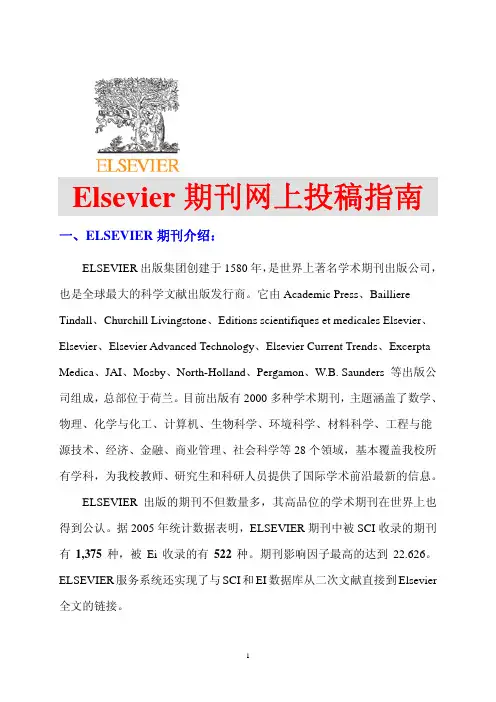
Elsevier期刊网上投稿指南一、ELSEVIER期刊介绍:ELSEVIER出版集团创建于1580年,是世界上著名学术期刊出版公司,也是全球最大的科学文献出版发行商。
它由Academic Press、Bailliere Tindall、Churchill Livingstone、Editions scientifiques et medicales Elsevier、Elsevier、Elsevier Advanced Technology、Elsevier Current Trends、Excerpta Medica、JAI、Mosby、North-Holland、Pergamon、W.B. Saunders 等出版公司组成,总部位于荷兰。
目前出版有2000多种学术期刊,主題涵盖了数学、物理、化学与化工、计算机、生物科学、环境科学、材料科学、工程与能源技术、经济、金融、商业管理、社会科学等28个領域,基本覆盖我校所有学科,为我校教师、研究生和科研人员提供了国际学术前沿最新的信息。
ELSEVIER出版的期刊不但数量多,其高品位的学术期刊在世界上也得到公认。
据2005年统计数据表明,ELSEVIER期刊中被SCI收录的期刊有1,375种,被Ei收录的有522种。
期刊影响因子最高的达到22.626。
ELSEVIER服务系统还实现了与SCI和EI数据库从二次文献直接到Elsevier 全文的链接。
目前,ELSEVIER出版集团在清华大学和上海交通大学图书馆设立镜像服务器,向校园网用户提供电子期刊全文数据库-ScienceDirect OnSite (SDOS)的服务;该站点装载了1995年以来该公司出版的1,774种电子期刊全文数据,文章篇数达2,731,1741篇。
读者也可以访问Elsevier美国主站点—ScienceDirect Online(SDOL)(/)。
SDOS和SDOL数据库均采用校园网范围的IP地址控制使用权限,不需要账号和口令,访问本地镜像和主站点都无需支付国际流量费。

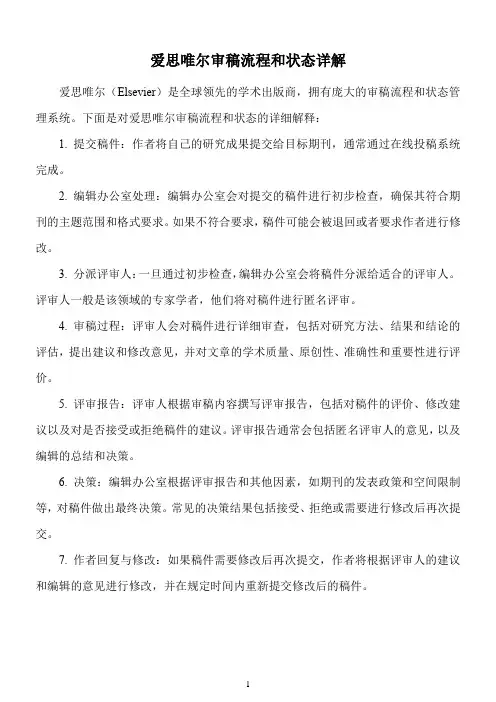
爱思唯尔审稿流程和状态详解爱思唯尔(Elsevier)是全球领先的学术出版商,拥有庞大的审稿流程和状态管理系统。
下面是对爱思唯尔审稿流程和状态的详细解释:1. 提交稿件:作者将自己的研究成果提交给目标期刊,通常通过在线投稿系统完成。
2. 编辑办公室处理:编辑办公室会对提交的稿件进行初步检查,确保其符合期刊的主题范围和格式要求。
如果不符合要求,稿件可能会被退回或者要求作者进行修改。
3. 分派评审人:一旦通过初步检查,编辑办公室会将稿件分派给适合的评审人。
评审人一般是该领域的专家学者,他们将对稿件进行匿名评审。
4. 审稿过程:评审人会对稿件进行详细审查,包括对研究方法、结果和结论的评估,提出建议和修改意见,并对文章的学术质量、原创性、准确性和重要性进行评价。
5. 评审报告:评审人根据审稿内容撰写评审报告,包括对稿件的评价、修改建议以及对是否接受或拒绝稿件的建议。
评审报告通常会包括匿名评审人的意见,以及编辑的总结和决策。
6. 决策:编辑办公室根据评审报告和其他因素,如期刊的发表政策和空间限制等,对稿件做出最终决策。
常见的决策结果包括接受、拒绝或需要进行修改后再次提交。
7. 作者回复与修改:如果稿件需要修改后再次提交,作者将根据评审人的建议和编辑的意见进行修改,并在规定时间内重新提交修改后的稿件。
8. 最终决策:编辑办公室会再次评估修改后的稿件,以确认是否满足期刊的要求。
如果满足要求,则稿件可能被接受并进入下一阶段的出版流程;如果不满足要求,则可能会被拒绝或要求进一步修改。
9. 出版准备:一旦稿件被接受,编辑办公室会与作者合作完成出版前的准备工作,包括校对、格式调整和版面设计等。
10. 正式出版:最终,经过出版准备的稿件将以印刷或电子形式正式发表,并在相应的学术数据库或期刊网站上公开发布。
在整个审稿流程中,爱思唯尔提供了一个状态管理系统,可以让作者随时跟踪自己的稿件状态。
常见的审稿状态包括:- Submitted(已提交):作者提交稿件后的初始状态。
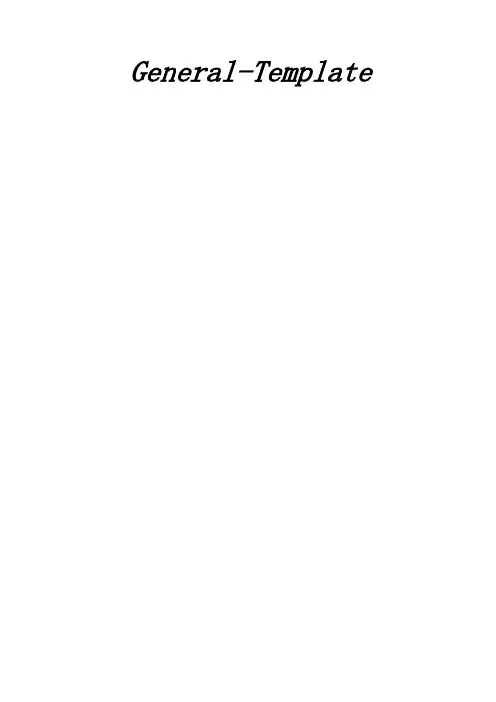
General-Template[Title Page]Article TitleAuthorsAuthor affiliationsCorrespondence information: Corresponding author name, affiliation, detailed permanent address, email address, telephone number(Check the Guide for authors to see the required information on the title page)Put the title of your abstract here using both upper and lower case letters, Times New Roman, 12?pts, bold, centered, double spacedA.?Author a,B.?Author b,C.?Author a,*a Department, University, Street, Postal-Code City, Countryb Laboratory, Institute, Street, Postal-Code City, CountryAbstractThis general template helps you on preparing manuscript for part of Elsevier Journals. Use this document as a template if you are using Microsoft Word 6.0 or later. Here comes self-contained abstract. Please read the Guide for Authors of your target journal for the requirements of Abstract. Pay special attention to the word count.PACS(optional, as per journal):Keywords:Keyword 1.D; Keyword 2.B (Read the Guide for Authors for the requirements for Keywords, including number, thesaurus, and classification indications)* Corresponding author. Tel.: +xx xxx xx xx; fax: +xx xxx xx xx.1. IntroductionThe manuscript should be prepared and submitted according to the Guide for Authors of your taget journal. . For your convenience, brief instructions on manuscript preparation are recorded below.Please DO consult a recent journal paper for style and conventions. You may find samples on ScienceDirect. You need to check your manuscript carefully before you submit it. The editor reserves the right to return manuscripts that do not conform to the instructions for manuscript preparation.2. General remarks on manuscript preparationGenerally, double line spacing, 12 pts font, and Times New Roman are preferred when you type the manuscript for review. This text formatting is provided in order to facilitate referee process and is also required for proper calculation of your manuscript length. Typing your manuscript follows the order: Title, Authors, Affiliations, Abstract, Keywords, Main text, Acknowledgements (optional), References (optional), Figure captions, Figures and Tables. Please consult the Guide for Authors for the proper organization of the main text. Ensure that each new paragraph is clearly indicated. Some journals also require lines to be numbered throughout the manuscript. You will usually want to divide your article into numbered sections and subsections. Present figures and tables at the right places mentioned in the Guide for Authors.Most formatting codes are removed or replaced while processing your article so there is no need for you to use excessive layout styling. Please do not use options such as automatic word breaking, double columns or automaticparagraph numbering (especially for numbered references). Do use bold face, italic, subscripts, superscripts, etc., as appropriate.2.1 IllustrationsMany journals required that figures and tables to be presented on separate pages at the end of the manuscript. The preferable file formats are: EPS (for vector graphics) and TIF (for bitmaps). However, PDF and MS Office (Word, Excel, Powerpoint figures) files are also acceptable. Use file names that enable to identify their contents in terms of figure number and format (e.g. fig1.tif, fig2.eps, fig3.pdf). All artwork has to be numbered according to its sequence in the text. All of them should have captions. Colour figures in printed version require an extra fee for most journals. Generally, no vertical rules (lines) should be used in tables. Illustrations should not duplicate descriptions that appear elsewhere in the manuscript.Please look at for more detailed instructions on artwork preparations.2.2 EquationsConventionally, in mathematical equations variables and anything thatrepresents a value appear in italics. You are encouraged to use equation-editing tools such as mathtype to edit equations. Please make use of the numbering and referencing functions.2.3 CitationsThere are different styles of in-text citations and reference lists. DO consult the Guide for Authors to see the given examples. Pay special attentionto the format of author names, journal names, publication year, volume and page span.AcknowledgementsThis section is optional.References[1].[2].Figure CaptionsFig.1 Put at this page the collected figure captions. The figure captions should be as brief as possible. It should also contain sufficient information that readers do not need to refer to the main text.Fig.2 Put here the figure caption of figure 2 (also the legend to figure 2). Fig. 3Fig.?1. Sample figure. Do not reduce or enlarge any images after placement in an MS Office application as this can lead to loss of image quality. While inserting vector graphics ensure that you use only truetype fonts. These should preferably be in one, or a combination, of the following fonts: Arial, Courier, Helvetica, Symbol, Times.Table 1Sample table: (使用三线表)a(Å) 4.5832 4.9365 Δ E a (eV) 1.745 1.592 ………………a This is an example of a table footnote.关于Elsevier旗下期刊投稿1 关于Elsevier旗下期刊投稿概述(1) Elsevier旗下共有1300多种期刊。
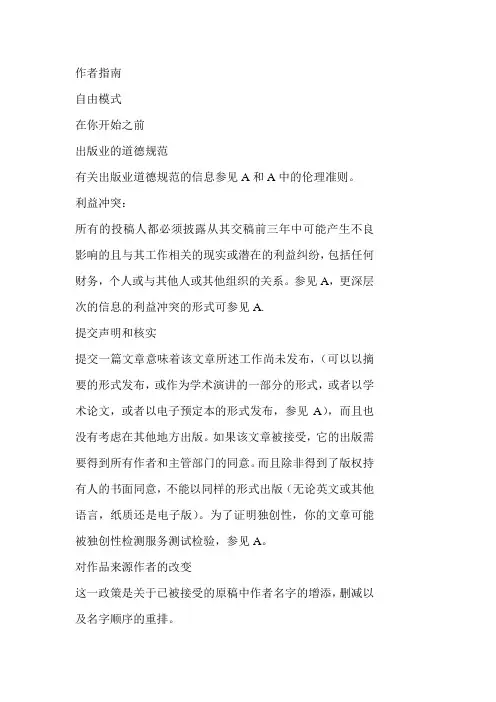
作者指南自由模式在你开始之前出版业的道德规范有关出版业道德规范的信息参见A和A中的伦理准则。
利益冲突:所有的投稿人都必须披露从其交稿前三年中可能产生不良影响的且与其工作相关的现实或潜在的利益纠纷,包括任何财务,个人或与其他人或其他组织的关系。
参见A,更深层次的信息的利益冲突的形式可参见A.提交声明和核实提交一篇文章意味着该文章所述工作尚未发布,(可以以摘要的形式发布,或作为学术演讲的一部分的形式,或者以学术论文,或者以电子预定本的形式发布,参见A),而且也没有考虑在其他地方出版。
如果该文章被接受,它的出版需要得到所有作者和主管部门的同意。
而且除非得到了版权持有人的书面同意,不能以同样的形式出版(无论英文或其他语言,纸质还是电子版)。
为了证明独创性,你的文章可能被独创性检测服务测试检验,参见A。
对作品来源作者的改变这一政策是关于已被接受的原稿中作者名字的增添,删减以及名字顺序的重排。
在被接受的稿件发表在网上之前,对于增添,删减,或重排作者名字的要求,必须发送到被接受稿件中有关作者的杂志管理者处,其内容必须包括(a) 作者名字被增加,删减或被重排的原因(b) 所有同意名字增添,删减,或重排的作者的书面确认(电子邮件,传真,信函),在作者被增添或删除的情况中,包括被增添或删改的作者的确认。
那些要求没有发送给相关作者而是由相关作者的杂志管理员提出的人,必须遵循的步骤,注明(1)杂志管理者是由杂志主编告知这一要求(2)直到作者同意,被接受的稿件才能发表到网上。
在被接受的稿件发表到网上之后:任何对于被发表文章中作者名字的增添,删减和重排的要求,将同样遵循上述政策并注明此处为被更改后的结果。
文章转接服务这本杂志是文章转接服务中的一方。
这意味着如果主编感觉你的文章更适合于我们同盟杂志中的任何一家,你将被建议考虑转投给这种另外一家杂志。
如果你同意,将自动以您的名义并不需要任何改动,更多的信息您可以参考A.版权该杂志提供作者对于发表的他们研究的选择:开放式访问或订阅。
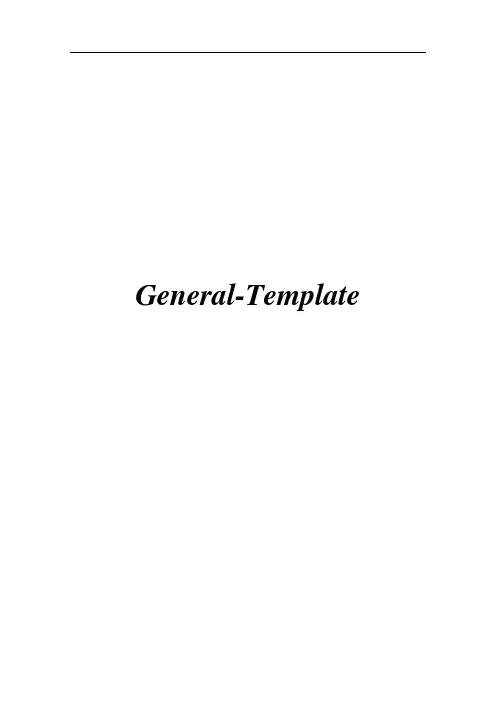
General-Template[Title Page]Article TitleAuthorsAuthor affiliationsCorrespondence information: Corresponding author name, affiliation, detailed permanent address, email address, telephone number(Check the Guide for authors to see the required information on the title page)Put the title of your abstract here using both upper and lower case letters, Times New Roman, 12 pts, bold, centered, double spacedA. Author a,B. Author b,C. Author a,*a Department, University, Street, Postal-Code City, Countryb Laboratory, Institute, Street, Postal-Code City, CountryAbstractThis general template helps you on preparing manuscript for part of Elsevier Journals. Use this document as a template if you are using Microsoft Word 6.0 or later. Here comes self-contained abstract. Please read the Guide for Authors of your target journal for the requirements of Abstract. Pay special attention to the word count.PACS(optional, as per journal): 75.40.-s; 71.20.LPKeywords:Keyword 1.D; Keyword 2.B (Read the Guide for Authors for the requirements for Keywords, including number, thesaurus, and classification indications)* Corresponding author. Tel.: +xx xxx xx xx; fax: +xx xxx xx xx. E-mail address: xxxxx@xxx.xx1. IntroductionThe manuscript should be prepared and submitted according to the Guide for Authors of your taget journal. . For your convenience, brief instructions on manuscript preparation are recorded below.Please DO consult a recent journal paper for style and conventions. You may find samples on ScienceDirect. You need to check your manuscript carefully before you submit it. The editor reserves the right to return manuscripts that do not conform to the instructions for manuscript preparation.2. General remarks on manuscript preparationGenerally, double line spacing, 12 pts font, and Times New Roman are preferred when you type the manuscript for review. This text formatting is provided in order to facilitate referee process and is also required for proper calculation of your manuscript length. Typing your manuscript follows the order: Title, Authors, Affiliations, Abstract, Keywords, Main text, Acknowledgements (optional), References (optional), Figure captions, Figures and Tables. Please consult the Guide for Authors for the proper organization of the main text. Ensure that each new paragraph is clearly indicated. Some journals also require lines to be numbered throughout the manuscript. You will usually want to divide your article into numbered sections and subsections. Present figures and tables at the right places mentioned in the Guide for Authors.Most formatting codes are removed or replaced while processing your article so there is no need for you to use excessive layout styling. Please do not use options suchas automatic word breaking, double columns or automatic paragraph numbering (especially for numbered references). Do use bold face, italic, subscripts, superscripts, etc., as appropriate.2.1 IllustrationsMany journals required that figures and tables to be presented on separate pages at the end of the manuscript. The preferable file formats are: EPS (for vector graphics) and TIF (for bitmaps). However, PDF and MS Office (Word, Excel, Powerpoint figures) files are also acceptable. Use file names that enable to identify their contents in terms of figure number and format (e.g. fig1.tif, fig2.eps, fig3.pdf). All artwork has to be numbered according to its sequence in the text. All of them should have captions. Colour figures in printed version require an extra fee for most journals. Generally, no vertical rules (lines) should be used in tables. Illustrations should not duplicate descriptions that appear elsewhere in the manuscript.Please look at .elsevier./wps/find/authors.authors/authorartworkinstructions for more detailed instructions on artwork preparations.2.2 EquationsConventionally, in mathematical equations variables and anything thatrepresents a value appear in italics. You are encouraged to use equation-editing tools such as mathtype to edit equations. Please make use of the numbering and referencing functions.2.3 CitationsThere are different styles of in-text citations and reference lists. DO consult the Guide for Authors to see the given examples. Pay special attention to the format of author names, journal names, publication year, volume and page span.AcknowledgementsThis section is optional.References[1].[2].Figure CaptionsFig.1 Put at this page the collected figure captions. The figure captions should be as brief as possible. It should also contain sufficient information that readers do not need to refer to the main text.Fig.2 Put here the figure caption of figure 2 (also the legend to figure 2).Fig. 3Fig. 1. Sample figure. Do not reduce or enlarge any images after placement in an MS Office application as this can lead to loss of image quality. While inserting vector graphics ensure that you use only truetype fonts. These should preferably be in one, or a combination, of the following fonts: Arial, Courier, Helvetica, Symbol, Times.Table 1Sample table: (使用三线表)Parameter Compound 1 Compound 2 a (Å) 4.5832 4.9365Δ E a (eV) 1.745 1.592 ………………a This is an example of a table footnote.关于Elsevier旗下期刊投稿1 关于Elsevier旗下期刊投稿概述(1) Elsevier旗下共有1300多种期刊。

General-Template[Title Page]Article TitleAuthorsAuthor affiliationsCorrespondence information: Corresponding author name, affiliation, detailed permanent address, email address, telephone number(Check the Guide for authors to see the required information on the title page)Put the title of your abstract here using both upper and lower case letters, Times New Roman, 12 pts, bold, centered, double spacedA. Author a,B. Author b,C. Author a,*a Department, University, Street, Postal-Code City, Countryb Laboratory, Institute, Street, Postal-Code City, CountryAbstractThis general template helps you on preparing manuscript for part of Elsevier Journals. Use this document as a template if you are using Microsoft Word 6.0 or later. Here comes self-contained abstract. Please read the Guide for Authors of your target journal for the requirements of Abstract. Pay special attention to the word count.PACS(optional, as per journal): 75.40.-s; 71.20.LPKeywords:Keyword 1.D; Keyword 2.B (Read the Guide for Authors for the requirements for Keywords, including number, thesaurus, and classification indications)* Corresponding author. Tel.: +xx xxx xx xx; fax: +xx xxx xx xx. E-mail address: xxxxx@xxx.xx1. IntroductionThe manuscript should be prepared and submitted according to the Guide for Authors of your taget journal. . For your convenience, brief instructions on manuscript preparation are recorded below.Please DO consult a recent journal paper for style and conventions. You may find samples on ScienceDirect. You need to check your manuscript carefully before you submit it. The editor reserves the right to return manuscripts that do not conform to the instructions for manuscript preparation.2. General remarks on manuscript preparationGenerally, double line spacing, 12 pts font, and Times New Roman are preferred when you type the manuscript for review. This text formatting is provided in order to facilitate referee process and is also required for proper calculation of your manuscript length. Typing your manuscript follows the order: Title, Authors, Affiliations, Abstract, Keywords, Main text, Acknowledgements (optional), References (optional), Figure captions, Figures and Tables. Please consult the Guide for Authors for the proper organization of the main text. Ensure that each new paragraph is clearly indicated. Some journals also require lines to be numbered throughout the manuscript. You will usually want to divide your article into numbered sections and subsections. Present figures and tables at the right places mentioned in the Guide for Authors.Most formatting codes are removed or replaced while processing your article so there is no need for you to use excessive layout styling. Please do not use options suchas automatic word breaking, double columns or automatic paragraph numbering (especially for numbered references). Do use bold face, italic, subscripts, superscripts, etc., as appropriate.2.1 IllustrationsMany journals required that figures and tables to be presented on separate pages at the end of the manuscript. The preferable file formats are: EPS (for vector graphics) and TIF (for bitmaps). However, PDF and MS Office (Word, Excel, Powerpoint figures) files are also acceptable. Use file names that enable to identify their contents in terms of figure number and format (e.g. fig1.tif, fig2.eps, fig3.pdf). All artwork has to be numbered according to its sequence in the text. All of them should have captions. Colour figures in printed version require an extra fee for most journals. Generally, no vertical rules (lines) should be used in tables. Illustrations should not duplicate descriptions that appear elsewhere in the manuscript.Please look at .elsevier./wps/find/authors.authors/authorartworkinstructions for more detailed instructions on artwork preparations.2.2 EquationsConventionally, in mathematical equations variables and anything thatrepresents a value appear in italics. You are encouraged to use equation-editing tools such as mathtype to edit equations. Please make use of the numbering and referencing functions.2.3 CitationsThere are different styles of in-text citations and reference lists. DO consult the Guide for Authors to see the given examples. Pay special attention to the format of author names, journal names, publication year, volume and page span.AcknowledgementsThis section is optional.References[1].[2].Figure CaptionsFig.1 Put at this page the collected figure captions. The figure captions should be as brief as possible. It should also contain sufficient information that readers do not need to refer to the main text.Fig.2 Put here the figure caption of figure 2 (also the legend to figure 2).Fig. 3Fig. 1. Sample figure. Do not reduce or enlarge any images after placement in an MS Office application as this can lead to loss of image quality. While inserting vector graphics ensure that you use only truetype fonts. These should preferably be in one, or a combination, of the following fonts: Arial, Courier, Helvetica, Symbol, Times.Table 1Sample table: (使用三线表)Parameter Compound 1 Compound 2 a (Å) 4.5832 4.9365Δ E a (eV) 1.745 1.592 ………………a This is an example of a table footnote.关于Elsevier旗下期刊投稿1 关于Elsevier旗下期刊投稿概述(1) Elsevier旗下共有1300多种期刊。
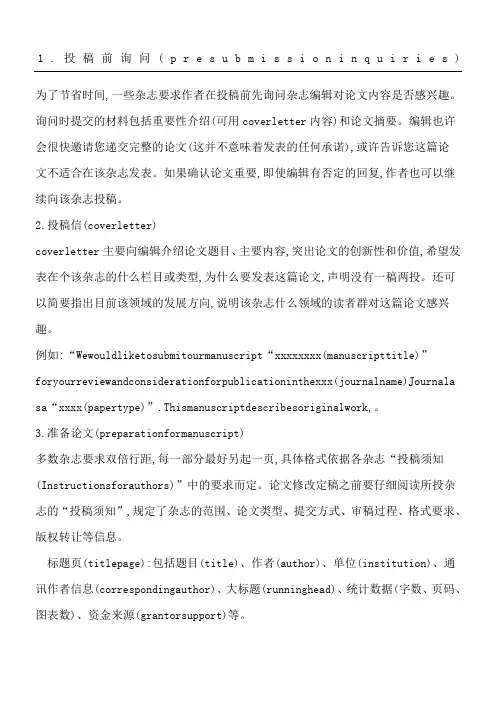
1.投稿前询问(p r e s u b m i s s i o n i n q u i r i e s)为了节省时间,一些杂志要求作者在投稿前先询问杂志编辑对论文内容是否感兴趣。
询问时提交的材料包括重要性介绍(可用coverletter内容)和论文摘要。
编辑也许会很快邀请您递交完整的论文(这并不意味着发表的任何承诺),或许告诉您这篇论文不适合在该杂志发表。
如果确认论文重要,即使编辑有否定的回复,作者也可以继续向该杂志投稿。
2.投稿信(coverletter)coverletter主要向编辑介绍论文题目、主要内容,突出论文的创新性和价值,希望发表在个该杂志的什么栏目或类型,为什么要发表这篇论文,声明没有一稿两投。
还可以简要指出目前该领域的发展方向,说明该杂志什么领域的读者群对这篇论文感兴趣。
例如:“Wewouldliketosubmitourmanuscript“xxxxxxxx(manuscripttitle)”foryourreviewandconsiderationforpublicationinthexxx(journalname)Journala sa“xxxx(papertype)”.Thismanuscriptdescribesoriginalwork,。
3.准备论文(preparationformanuscript)多数杂志要求双倍行距,每一部分最好另起一页,具体格式依据各杂志“投稿须知(Instructionsforauthors)”中的要求而定。
论文修改定稿之前要仔细阅读所投杂志的“投稿须知”,规定了杂志的范围、论文类型、提交方式、审稿过程、格式要求、版权转让等信息。
标题页(titlepage):包括题目(title)、作者(author)、单位(institution)、通讯作者信息(correspondingauthor)、大标题(runninghead)、统计数据(字数、页码、图表数)、资金来源(grantorsupport)等。
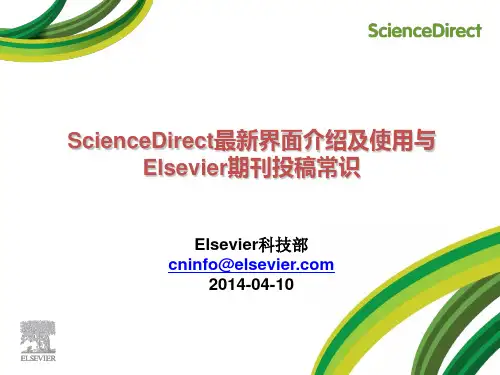
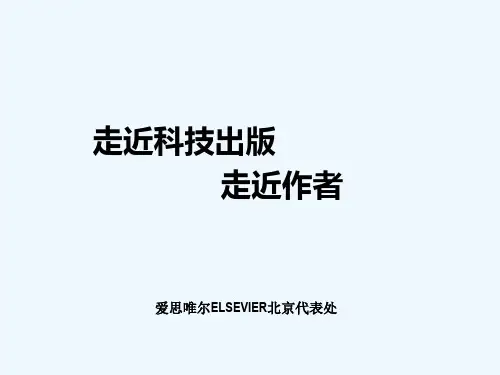
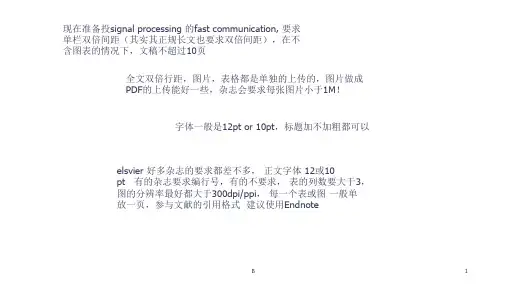
1 .投稿前询问(presubmi ssi oni nqui r i es)为了节省时间,一些杂志要求作者在投稿前先询问杂志编辑对论文内容是否感兴趣。
询问时提交的材料包括重要性介绍(可用coverletter 内容)和论文摘要。
编辑也许会很快邀请您递交完整的论文(这并不意味着发表的任何承诺),或许告诉您这篇论文不适合在该杂志发表。
如果确认论文重要,即使编辑有否定的回复,作者也可以继续向该杂志投稿。
2. 投稿信(coverletter)coverletter 主要向编辑介绍论文题目、主要内容,突出论文的创新性和价值,希望发表在个该杂志的什么栏目或类型,为什么要发表这篇论文,声明没有一稿两投。
还可以简要指出目前该领域的发展方向,说明该杂志什么领域的读者群对这篇论文感兴趣。
例女口:“Wewouldliketosubmitourmanuscript“xxxxxxxx(manuscripttitle) ”foryourreviewa ndcon siderati on forpublicatio nin thexxx(journal nameJournala sa “xxxx(papertype) ” .Thismanuscriptdescribesoriginalwork, 。
3. 准备论文(preparati on forma nu script)多数杂志要求双倍行距,每一部分最好另起一页,具体格式依据各杂志“投稿须知(In structio nsforauthors) ”中的要求而定。
论文修改定稿之前要仔细阅读所投杂志的“投稿须知”,规定了杂志的范围、论文类型、提交方式、审稿过程、格式要求、版权转让等信息。
标题页(titlepage): 包括题目(title)、作者(author)、单位(institution) 、通讯作者信息(correspondingauthor)、大标题(runninghead)、统计数据(字数、页码、图表数)、资金来源(grantorsupport) 等。
Elsevier期刊网上投稿指南浙江工业大学图书馆信息咨询部编写Elsevier是荷兰一家全球著名的学术期刊出版商,每年出版大量的农业和生物科学、化学和化工、临床医学、生命科学、计算机科学、地球科学、工程、能源和技术、环境科学、材料科学、航空航天、天文学、物理、数学、经济、商业、管理、社会科学、艺术和人文科学类的学术图书和期刊,出版的1800种期刊中大部分期刊是被SCI、SSCI、EI收录的核心期刊,其中SCI、SSCI收录期刊1,221种,EI收录期刊515种,社科类期刊数量为255种(SCI、SSCI收录期刊152种)、科技类期刊数量1,302种(SCI收录期刊1069种)是世界上公认的高品位学术期刊。
Elsevier期刊提供了在线投稿的作者服务(Author gateway),服务网址:,可以查看所有期刊的投稿要求、编委组成、投稿渠道等信息。
Elsevier以支持全球学术交流为宗旨,不向作者收取刊登论文的版面费(注:当作者希望在文章中刊登彩色图片,如仅为电子版本也免收版面费,但如果作者在纸本期刊中仍要求彩色插图,各期刊会酌情收取费用)。
对于非英语国家和地区的作者,如果在英文撰稿方面存在语言困难,爱思唯尔向您建议专业的语言校对中心,他们可以帮助您进行语言校对和稿件加工。
详细情况,可以点击/LanguageEditing.html,或者与作者支持部门联系(邮件地址:authorsupport@)。
图1:Elsevier期刊投稿主页作者指南网上投稿向Elsevier期刊投稿,有几种情况:一是在作者服务网址(author gateway)上一次注册后,点击submit online to this journal按钮就可以对多种期刊直接进行网上投稿;二是有些刊不接受author gateway上注册的作者对该刊进行网上投稿,也就是说在点击submit online tothis journal 按钮后显示该刊不接受在author gateway 注册的用户进行网上投稿,这时需要重新在该刊主页进行注册后方可对该刊进行网上投稿;三是有些刊根本不接受网上投稿,需要邮寄纸本的稿件过去。
Elsevier_投稿各种状态总结Elsevier 投稿各种状态总结1. Submitted to Journal当上传结束后,显示的状态是Submitted to Journ al,这个状态是自然形成的无需处理。
2. With editor如果在投稿的时候没有要求选择编辑,就先到主编那,主编会分派给别的编辑。
这当中就会有另两个状态:3. Editor assigned4. Editor Declined Invitation如果编辑接手处理了就会邀请审稿人了。
5. Reviewer invited如果审稿人接受那就会是以下状态:6. Under review这应该是一个漫长的等待。
当然前面各步骤也可能很慢的,要看编辑的处理情况。
如果被邀请审稿人不想审,就会decline,编辑会重新邀请别的审稿人。
7. required review completed 审稿结束,等编辑处理。
8. Decision in Process到了这一步就快要有结果了,编辑开始考虑是给修改还是直接拒,当然也有可能直接接受的,但可能性很小,呵呵。
9. Minor revision/Major revision这个时候可以稍微庆祝一下了,问题不大了,因为有修改就有可能。
具体怎么改就不多说了,谦虚谨慎是不可少的。
10. Revision Submitted to Journal又开始了一个循环。
11. Accepted如果不要再审,只是小修改,编辑看后会马上显示这个状态,但如果要再审也会有上面的部分状态。
一步会比较快,但也有慢的。
看杂志的。
还有个状态是Rejected。
希望不要出现。
其他库的状态,基本是大同小异,供参考:In the Rapid Review?system, your manuscript has a differentstatus ass igned to it at various stages in the process. Below is a list of the status descriptions used with brief explanations.Incomplete Submission... you have begun the submission process. The su bmission has been assigned a temporary (TMP) manuscript number. You must complete the submission process.Finish My Submission... by viewing and approving the MS PDF. Once this is done, the submission will be assigned a permanent manuscript numbe r.MS at Check-In... the manuscript is pending a quality check by the staff or editor. This involves verifying that the MS PDF contains a complete m anuscript (text, tables, figures, etc.) and is suitable for review purposes. Conversion to PDF in Process... If the manuscript was submitted digitally, the MS PDF did not pass the QC process and is not suitable for review purposes. The staff may be in the process of converting the digital files t o a new MS PDF or staff may have requested that the author send new file. The Journal Office is waiting for the fileto upload for conversion purposes.MS Being Pre-screened... if you submitted a manuscript to a journal whos e review process includes pre-screening, this status indicates that the ma nuscript (or the abstract) is currently being pre-screened to determine its appropriateness for the journal.MS In Review... the manuscript has been assigned to an editor and may be awaiting reviewer selections, or the awaiting reviews.Decision Pending... the manuscript has been reviewed and the editor is in the process of making a decision.MS in Revision (Optional)... a decision to accept the paper with optional r evisions (as suggested in the reviewer or editorcomments) has been ma de by the editor, and a letter requesting these revisions has been sent t o the author. Resubmission is anticipated.MS in Revision (Minor)... a decision to accept the paper with minor revisi ons (as suggested in the reviewer or editor comments) has been made b y the editor, and a letter requesting these revisions has been sent to the author. Resubmission is anticipated.MS in Revision (Major)... a decision to reconsider the paper after major r evisions (as suggested in the reviewer or editor comments) has been ma de by the editor, and a letter requesting these revisions has been sent t o the author. Resubmission is permitted.MS Rejected... a decision to decline publication has been made by the ed itor, and a rejection letter has been sent to the author.MS Accepted... a decision to accept the paper has been made by the edi tor, and an acceptance letter has been sent to the author.MS Withdrawn... the manuscript has been withdrawn at the author's requ est. No resubmission is permitted. Any further version must be considere d as a brand new submission.MS Deactivated... the manuscript has been deactivated due to the author' s non-response in resubmitting a revised version or, in some instances, t o the editor's invitation to submit a solicited paper.MS Published... the review process is complete and the manuscript is aw aiting publication or it has already been published.Invitation/Submit Invited Paper... the editor has extended toyou an invit ation to submit a paper on a proposed topic. You are asked to reply by using the "Reply to Invitation" button. If you and the editor are in agree ment, you can submit the invited paper by using the "Submit Invited MS " button.。